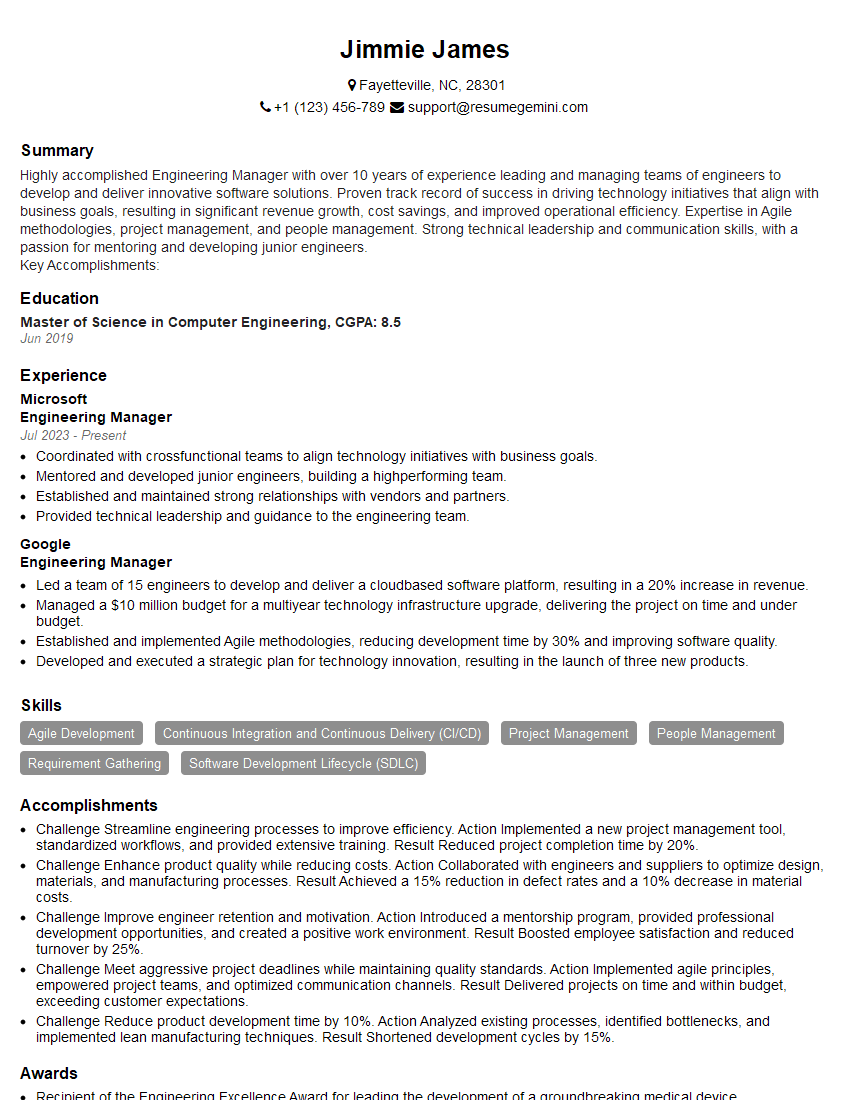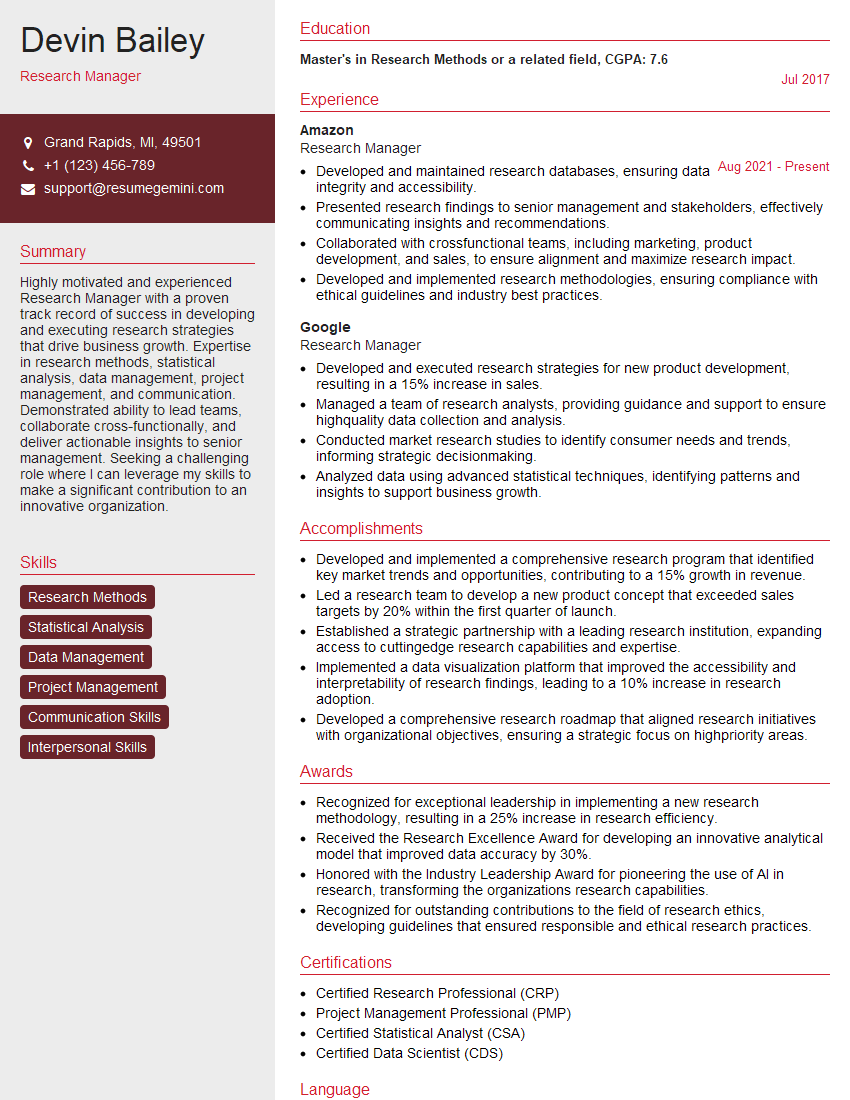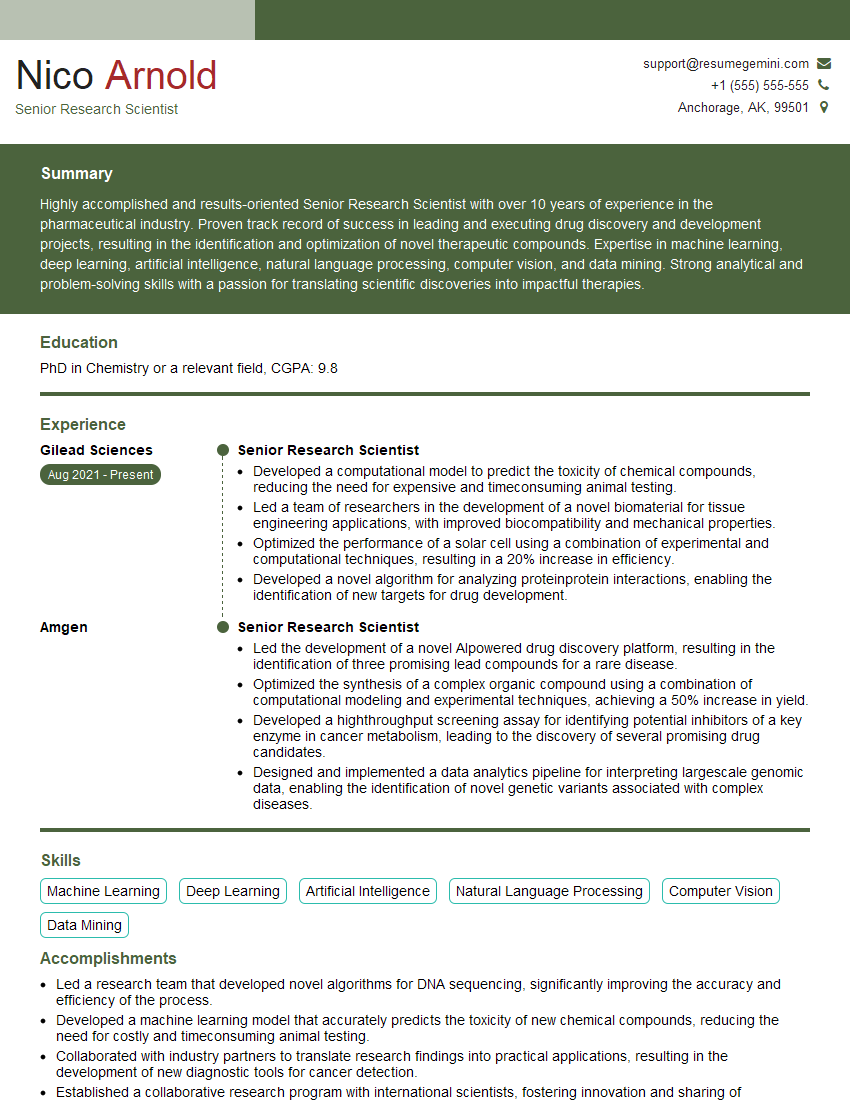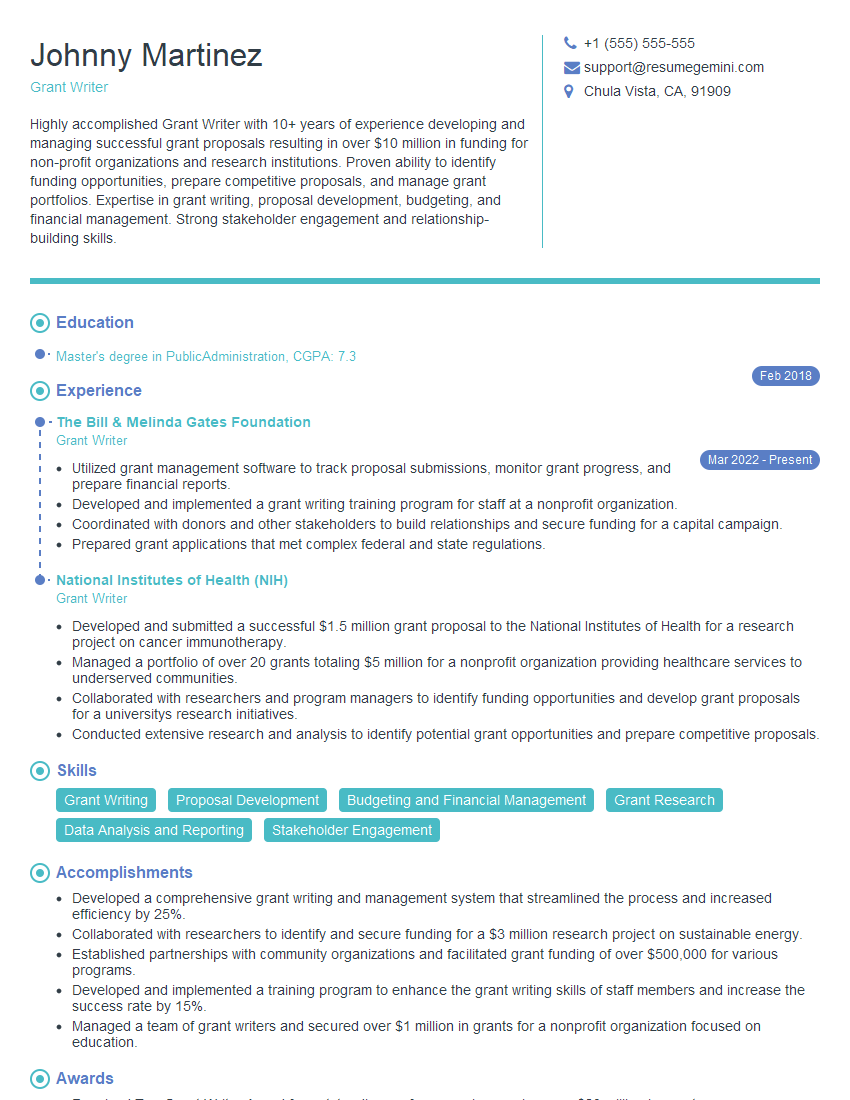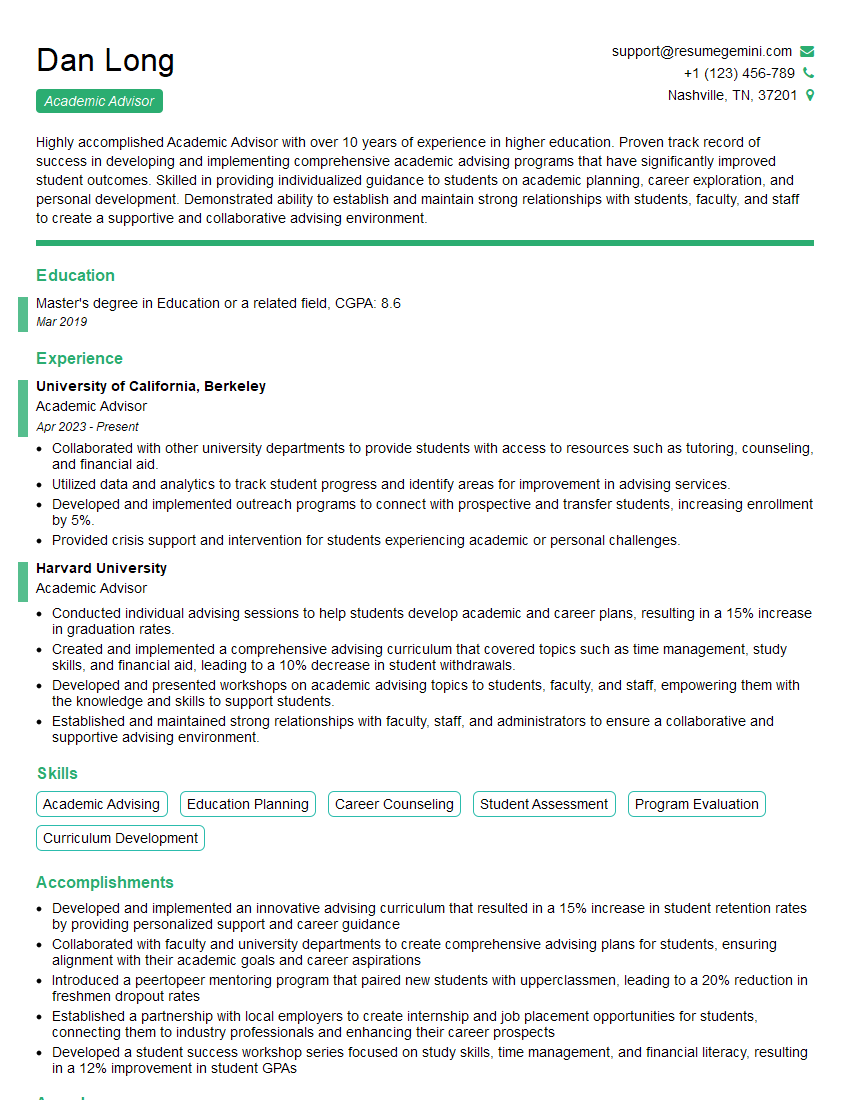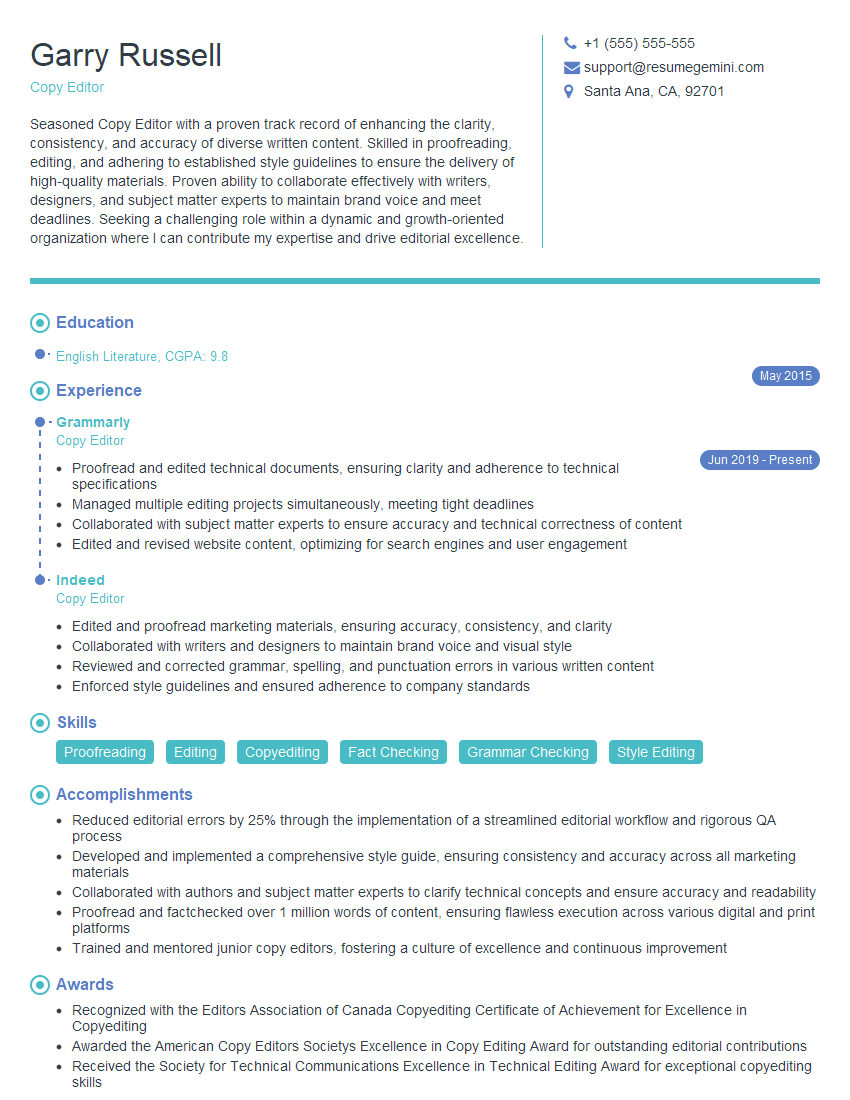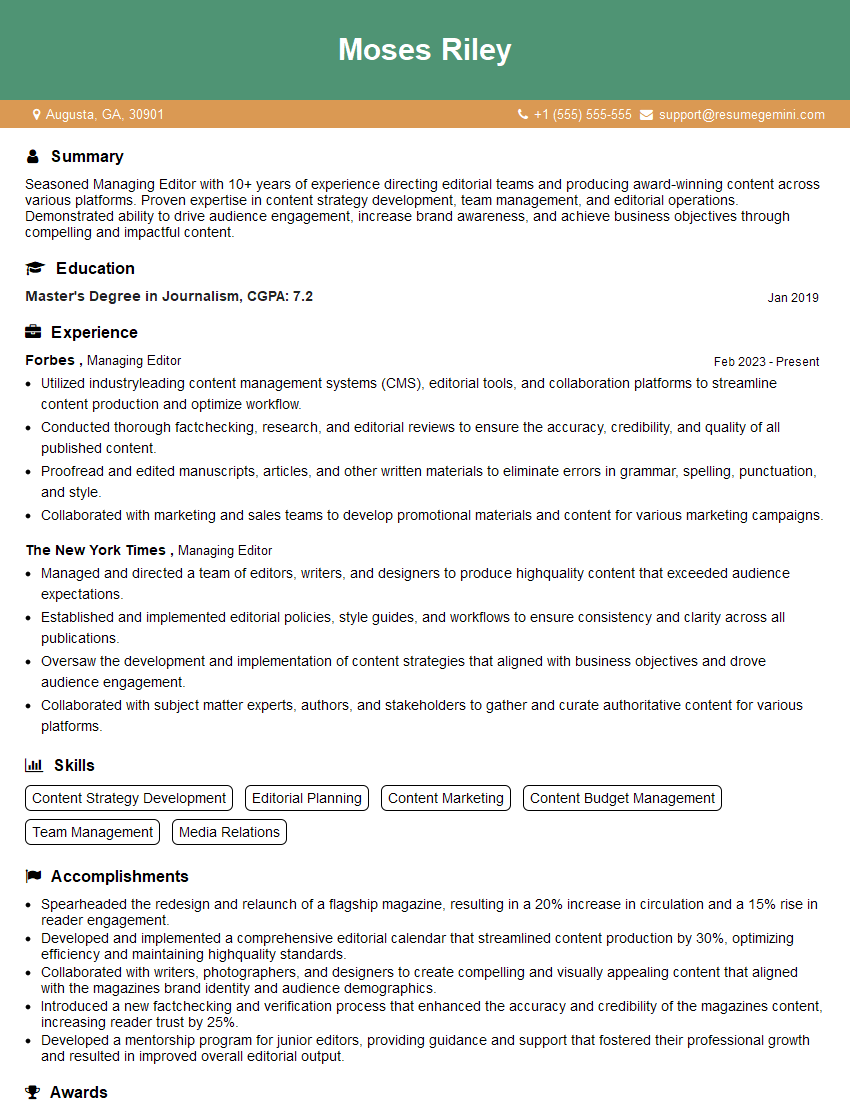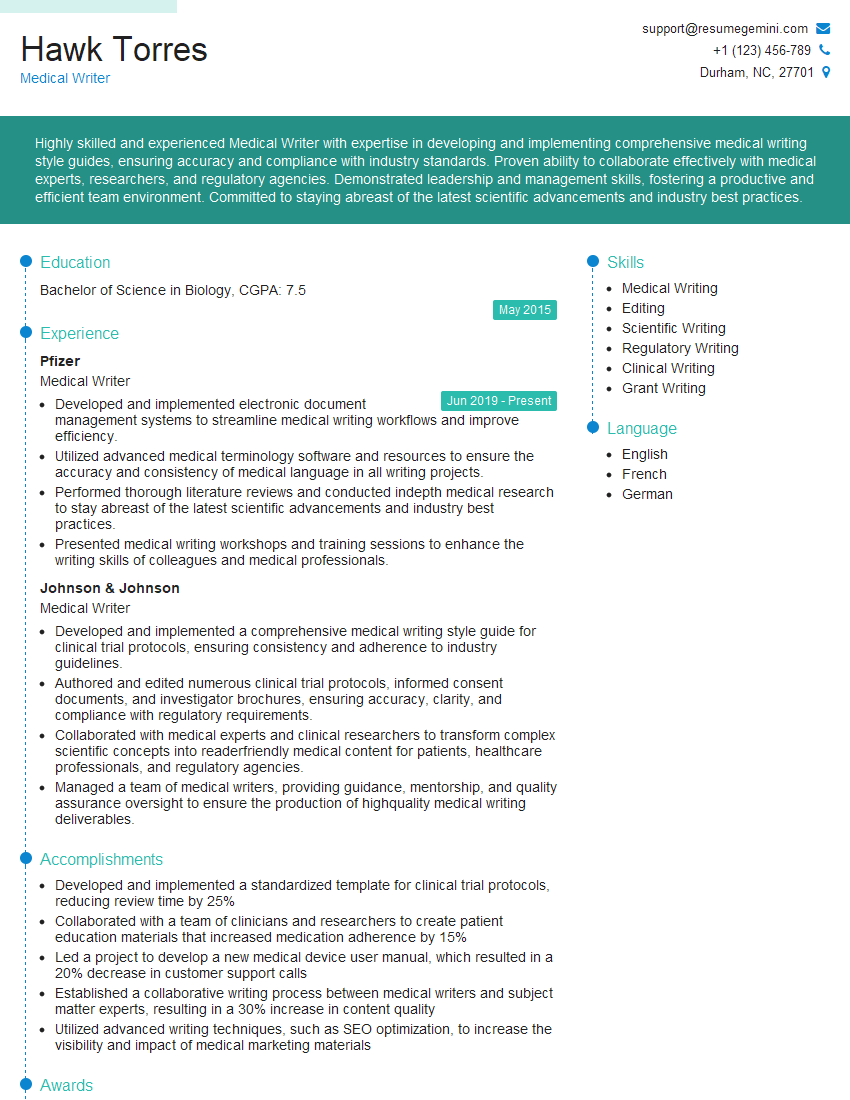The thought of an interview can be nerve-wracking, but the right preparation can make all the difference. Explore this comprehensive guide to Experience with Peer Review Process interview questions and gain the confidence you need to showcase your abilities and secure the role.
Questions Asked in Experience with Peer Review Process Interview
Q 1. Describe your experience with the peer review process.
My experience with the peer review process spans over a decade, encompassing various roles – from being a reviewer myself to serving as an editor overseeing the process. I’ve reviewed manuscripts across diverse disciplines, including computer science, engineering, and business management. This broad experience has given me a deep understanding of the nuances involved, from initial submission to final publication decisions. I’ve reviewed for both academic journals and industry conferences, navigating different styles and expectations. I’m familiar with both quantitative and qualitative research methodologies and can effectively assess the rigor and validity of findings.
For instance, in a recent review of a machine learning paper, I assessed the novelty of the proposed algorithm, the rigor of its experimental evaluation, and the clarity of the presentation. My feedback included suggestions for improving the experimental design, addressing potential biases, and clarifying certain technical aspects. I’ve also mentored junior researchers on improving their writing and understanding the expectations of the peer-review process.
Q 2. What are the key stages involved in a typical peer review process?
A typical peer review process generally involves these key stages:
- Submission: The author submits their work to a journal or conference.
- Initial Assessment by Editor: The editor assesses the suitability of the submission based on scope, quality, and originality. Unsuitable submissions are rejected at this stage.
- Reviewer Selection: The editor identifies suitable reviewers based on their expertise and experience.
- Review: Reviewers critically evaluate the submission, providing feedback on its strengths and weaknesses, and recommending acceptance, rejection, or revision.
- Author Response: Authors respond to reviewers’ comments and address concerns raised. This often involves significant revisions and resubmission.
- Final Decision: The editor makes a final decision based on the reviewers’ feedback and the authors’ responses.
- Publication (if accepted): The accepted manuscript undergoes further editing and is eventually published.
Q 3. Explain the difference between single-blind and double-blind peer review.
The key difference between single-blind and double-blind peer review lies in the anonymity of the participants. In single-blind review, the reviewers’ identities are concealed from the authors, but the authors’ identities are known to the reviewers. This is common practice. In double-blind review, both the reviewers and the authors remain anonymous to each other. This aims to reduce potential bias stemming from the authors’ reputation or affiliations. However, double-blind review is challenging to implement perfectly, as authors’ writing styles and affiliations can sometimes be inadvertently revealed.
Imagine a scenario: A renowned researcher submits their work. In a single-blind review, reviewers might be subconsciously influenced by the author’s reputation. Double-blind aims to mitigate this, focusing purely on the merits of the work itself.
Q 4. How do you ensure objectivity and fairness during peer review?
Objectivity and fairness are paramount in peer review. I ensure these by adhering to the following principles:
- Focusing on the work itself: I evaluate the research based on its methodology, results, and contribution, rather than personal opinions or biases.
- Applying consistent standards: I use consistent criteria for evaluating submissions across different contexts, avoiding subjective evaluations.
- Avoiding conflicts of interest: I recuse myself from reviewing submissions if there’s any conflict of interest, such as prior collaborations or competing research.
- Being thorough and detailed: I provide detailed and specific feedback, supporting my assessments with evidence from the manuscript.
- Staying up-to-date: I continuously update my knowledge and understanding of current research practices and standards.
Q 5. How do you handle disagreements with reviewers’ feedback?
Disagreements with reviewers’ feedback are common. My approach is collaborative and focused on constructive dialogue. I begin by carefully considering the reviewer’s rationale. Is it based on misunderstandings, different interpretations, or valid concerns? I would then:
- Engage in respectful communication: I communicate my concerns to the editor, clarifying my disagreements in a professional manner. I would highlight the specific points of disagreement and provide justifications for my perspective.
- Provide evidence: I would support my position with strong evidence, citing relevant literature or offering alternative interpretations of the data.
- Consider revisions: Even if I disagree, I am open to revisions that address valid points. The goal is to improve the manuscript, not to win an argument.
If the disagreement persists, I would defer to the editor’s judgment, understanding their role in making the final decision.
Q 6. How do you provide constructive criticism during peer review?
Constructive criticism involves providing specific and actionable feedback, guiding the authors toward improvement rather than simply pointing out flaws. I follow a framework that involves:
- Highlighting strengths: I start by acknowledging the positive aspects of the work, creating a positive context for the feedback.
- Focusing on specific issues: I provide detailed and specific examples to illustrate the areas needing improvement, avoiding vague or general comments.
- Offering suggestions for improvement: I offer concrete suggestions for addressing the identified issues, providing practical guidance rather than just criticisms.
- Maintaining a professional tone: I use a respectful and professional tone, avoiding accusatory or demeaning language.
- Considering the context: I take into account the authors’ experience level and the specific context of the research when providing feedback.
For example, instead of saying “Your writing is unclear,” I would say, “The explanation of the algorithm on page 5 is difficult to follow. Consider restructuring the paragraph and providing a more detailed explanation of steps 3 and 4.”
Q 7. What are some common challenges you’ve faced during the peer review process?
Some common challenges I’ve faced include:
- Time constraints: Meeting deadlines while providing thorough reviews can be challenging, particularly when dealing with multiple submissions.
- Poorly written submissions: Reviewing poorly written or poorly organized submissions can be time-consuming and frustrating.
- Reviewers’ conflicting opinions: Reconciling conflicting opinions from multiple reviewers can be difficult and requires careful consideration and mediation.
- Dealing with authors who are resistant to feedback: Some authors might be defensive or resistant to constructive criticism, which can hinder the improvement process. I’ve found that empathy and a collaborative spirit are essential.
- Maintaining objectivity when dealing with submissions outside your immediate expertise: It can be challenging to evaluate submissions on topics outside one’s specific area of expertise, which requires careful reading and potentially seeking additional information. I utilize existing literature and leverage my broader scientific understanding in such cases.
Q 8. How do you ensure the confidentiality of submissions during peer review?
Confidentiality is paramount in peer review. We treat submissions as strictly privileged information. This starts with anonymizing the manuscript – removing author names and affiliations – before it’s sent to reviewers. The review process itself is managed through secure platforms that utilize access controls, encryption, and audit trails. Reviewers are explicitly bound by confidentiality agreements, reminding them of the serious implications of breaching this trust. For example, I’ve worked with systems where reviewers only access the manuscript via a dedicated, password-protected portal, preventing downloads or unauthorized sharing. Any communication about the submission is also kept within the confines of the review platform, eliminating the risk of accidental disclosure through email or other less secure channels.
Q 9. How do you manage the workload and timelines associated with peer review?
Managing workload and timelines requires careful planning and communication. I typically start by assessing the number of submissions and the available reviewers. Realistic deadlines are set, factoring in the complexity of the submissions and the reviewers’ expertise and availability. Regular check-ins with reviewers are crucial to ensure they’re on track and address any potential delays. If a reviewer is struggling to meet the deadline, I explore the reasons and offer support, such as extending the deadline or finding a replacement if necessary. A Gantt chart or similar project management tool can be very helpful in visualizing the workflow and proactively identifying potential bottlenecks. For instance, in one project, we successfully used a Trello board to track the progress of each submission, assigning tasks to different team members and highlighting potential conflicts or delays early.
Q 10. Describe your experience with peer review software or platforms.
I have extensive experience with various peer review platforms, including ScholarOne Manuscripts, Editorial Manager, and PeerJ. These platforms offer a range of features designed to streamline the review process. Key features include secure manuscript submission and distribution, automated reminders and notifications, centralized communication between editors, reviewers, and authors, and robust tracking of the review progress. For example, using ScholarOne, I’ve streamlined the process of assigning reviewers, tracking their reviews, and managing communication – all within a secure, centralized environment. The ability to provide anonymous reviews and track reviewer performance metrics has also been invaluable. Each platform has its nuances, but understanding their features is essential for efficient and ethical peer review.
Q 11. How do you balance your own workload with participating in the peer review process?
Balancing personal workload with peer review participation requires careful time management and prioritization. I dedicate specific blocks of time in my schedule solely for peer review activities. This prevents peer review tasks from spilling over into other work and helps ensure that reviews are completed thoroughly and within deadlines. I communicate my availability to editors transparently, accepting only the number of reviews I can reasonably manage without compromising the quality of my work. Prioritizing reviews based on my expertise and the urgency of the publication schedule also helps me stay organized and maintain a healthy work-life balance. For example, I might prioritize reviewing manuscripts in my area of specific expertise even if the deadline is further out.
Q 12. What criteria do you consider when evaluating the quality of a submission?
Evaluating submissions involves a multi-faceted assessment. I consider several key criteria:
- Originality and Significance: Does the research contribute new knowledge or insights to the field? Is the problem addressed important and relevant?
- Methodology: Is the research design sound and appropriate? Are the methods clearly described and justified?
- Data Analysis and Interpretation: Are the data analyzed correctly and are the interpretations supported by the evidence?
- Clarity and Presentation: Is the manuscript well-written, organized, and easy to follow? Are the figures and tables clear and informative?
- Literature Review: Is the existing literature adequately reviewed and synthesized? Is the research appropriately placed within the current body of knowledge?
Q 13. How do you handle conflicts of interest that may arise during peer review?
Conflicts of interest are handled with utmost transparency and integrity. At the beginning of the review process, I always declare any potential conflicts of interest, such as collaborations with the authors, previous work on related topics, or personal relationships. If a conflict is identified, I recuse myself from the review. The editor is then informed, and a new reviewer is selected. Transparency is key to maintaining the fairness and credibility of the peer review process. There is no room for biased judgment. In one instance, I discovered a potential conflict after beginning the review. I immediately informed the editor and withdrew, explaining the circumstances to ensure the ethical standards were maintained.
Q 14. How do you assess the originality and novelty of a submission?
Assessing originality and novelty requires a thorough understanding of the existing literature. I begin by researching the topic to determine whether the submission’s claims are truly new or represent incremental improvements. Key questions I ask myself include: Has this research been conducted before? Does the submission offer a novel perspective or approach? Does it provide new evidence or data that challenges or extends existing knowledge? I also consider the impact of the submission. Could it significantly change understanding in the field, open up new areas of inquiry, or lead to practical applications? This holistic evaluation helps ensure that originality and novelty are appropriately assessed, and ensures I am not simply assessing replication or minor extensions of previously published work.
Q 15. How do you identify plagiarism or other forms of academic misconduct during peer review?
Identifying plagiarism and academic misconduct during peer review requires a keen eye and a methodical approach. It’s not just about looking for verbatim copying; it’s about detecting instances of paraphrasing without proper attribution, inappropriate use of sources, and self-plagiarism.
Software tools: I utilize plagiarism detection software like Turnitin to compare the manuscript against a vast database of published works and online resources. This provides a preliminary screening for potential matches.
Manual review: Software isn’t foolproof. I carefully read the manuscript, paying close attention to the references and citations. Discrepancies between the cited source and the text itself are red flags. Unusual writing styles or inconsistencies within the text might also indicate potential issues.
Comparison with prior work: If I’m familiar with the author’s previous publications, I carefully compare the submitted work to their earlier research to look for excessive similarities or duplication of content, an example of self-plagiarism.
Source analysis: I delve deeper into the cited sources to ensure that they truly support the claims made in the manuscript. If the referenced material doesn’t adequately back up the author’s statements, it could be a sign of fabrication or misrepresentation.
If any of these red flags are raised, I thoroughly investigate further before making a final determination. I document my findings meticulously and report my concerns to the journal editor.
Career Expert Tips:
- Ace those interviews! Prepare effectively by reviewing the Top 50 Most Common Interview Questions on ResumeGemini.
- Navigate your job search with confidence! Explore a wide range of Career Tips on ResumeGemini. Learn about common challenges and recommendations to overcome them.
- Craft the perfect resume! Master the Art of Resume Writing with ResumeGemini’s guide. Showcase your unique qualifications and achievements effectively.
- Don’t miss out on holiday savings! Build your dream resume with ResumeGemini’s ATS optimized templates.
Q 16. What is your experience with different peer review models (e.g., open peer review)?
My experience encompasses various peer review models, each with its own strengths and weaknesses. I’ve participated in both traditional, single-blind peer review (where the reviewer’s identity is hidden from the author) and open peer review, where both the reviewer and author’s identities are revealed.
Traditional single-blind review: This model is well-established and offers anonymity to protect reviewers from potential bias or retaliation. However, it can sometimes lead to less constructive criticism due to the lack of accountability.
Open peer review: This model fosters transparency and accountability. The openness can encourage more constructive and thoughtful feedback, as reviewers are more likely to engage in a civil discussion. However, it can also increase the risk of personal attacks or biases from reviewers.
Double-blind review: In this approach, neither the author nor the reviewer knows the identity of the other party. This approach aims to minimize bias but sometimes poses challenges in identifying an author’s prior work, making plagiarism detection more difficult.
I’ve also had some experience with collaborative review models, where multiple reviewers work together to provide a unified assessment. This approach can be highly efficient and produces more comprehensive feedback.
Q 17. How do you provide feedback that is both critical and supportive?
Providing feedback that’s both critical and supportive is a delicate balancing act. The goal is to help the author improve their work without being overly harsh or discouraging. I approach this by focusing on the work itself, not the author’s personality or abilities.
Start with the positive: I always begin by acknowledging the strengths of the paper. This sets a positive tone and shows that I’ve engaged with the work seriously. For instance, I might say, “The introduction effectively lays out the problem’s context.”
Constructive criticism: I then offer specific and actionable feedback on areas needing improvement. Instead of saying “The methodology is flawed,” I suggest, “The sample size could be increased to enhance the statistical power of the findings.” Providing concrete suggestions for improvement makes the critique more helpful.
Focus on clarity and precision: I aim for clear and concise language, avoiding vague or ambiguous statements. I use language such as “Consider revising the section to improve clarity” rather than “this part is confusing”.
Use a professional tone: Maintaining a respectful and professional tone is paramount, even when pointing out shortcomings. I strive to avoid language that could be perceived as condescending or dismissive.
I believe in offering the kind of feedback I would appreciate receiving—detailed, honest, and constructive. This combination helps authors improve while encouraging further research.
Q 18. Describe a situation where you had to defend a peer review decision.
In one instance, I recommended rejecting a manuscript due to significant methodological flaws and a lack of originality. The author strongly disagreed, arguing that the methodology was sound and the findings novel. The editor sought clarification, so I provided a detailed explanation, supported by examples from the literature, illustrating why the methodology was insufficient and the findings were not unique. I also highlighted inconsistencies in the author’s responses to my initial feedback.
I presented the evidence objectively, focusing on the scientific merits of the study rather than resorting to personal opinions. Ultimately, the editor agreed with my assessment, and the manuscript was rejected. While it was uncomfortable defending the decision, the process reinforced the importance of rigorous evaluation in maintaining academic standards.
Q 19. How do you manage the emotional aspects of providing and receiving negative feedback?
Managing the emotional aspects of peer review, especially when delivering negative feedback, requires self-awareness and empathy. It’s essential to remember that the goal is to improve the quality of scholarship, not to hurt the author’s feelings.
Separate the work from the author: I remind myself that I’m evaluating the work, not the person. The feedback is about the manuscript’s merits and shortcomings, not the author’s capability or character.
Empathy: I try to put myself in the author’s shoes. Writing and submitting a paper is a vulnerable act. Therefore, I strive to give feedback in a way that is constructive and supportive.
Self-reflection: I also reflect on my own reactions to feedback I’ve received. This helps me understand how to better approach providing negative feedback to others.
Professional detachment: While empathy is important, maintaining a degree of professional detachment ensures that personal feelings don’t cloud my judgment.
Receiving negative feedback can be challenging, but I see it as an opportunity for growth. I analyze the feedback objectively, focusing on the constructive aspects and identifying areas where I can improve.
Q 20. How do you handle situations where the quality of a submission is significantly below standard?
Handling submissions significantly below standard requires a careful and sensitive approach. It’s crucial to provide feedback that is both honest and constructive, while also recognizing that authors may be inexperienced or lacking resources.
Early identification: If, during an initial screening, I find a manuscript severely lacking in quality, I may recommend it for rejection early on, saving both the author and the reviewers time.
Detailed feedback: If the submission has some potential but needs significant revisions, I would offer more thorough and detailed feedback, clearly articulating the key weaknesses and outlining the necessary improvements. This would include issues regarding structure, methodology, clarity, or lack of originality.
Suggesting resources: Depending on the journal’s guidelines and the specific nature of the shortcomings, I might suggest resources that could help the authors improve their work. This could include style guides, tutorials on research methodology, or relevant books.
Suggesting resubmission: In some cases, a comprehensive list of improvements may justify encouraging the author to revise and resubmit the manuscript after addressing the issues highlighted. However, I would make it clear that the quality must dramatically improve before reconsideration.
Ultimately, my goal is to guide authors toward better scholarly practices while upholding the journal’s standards.
Q 21. What are your views on the role of peer review in maintaining academic integrity?
Peer review plays a vital role in maintaining academic integrity. It acts as a gatekeeper, ensuring the quality and validity of research before publication. By subjecting research to scrutiny by experts in the field, peer review helps to:
Identify and prevent plagiarism and other forms of misconduct: The review process allows for the detection of plagiarism, fabricated data, and other instances of academic dishonesty, thus maintaining the integrity of the published literature.
Improve the quality of research: Constructive feedback from peers leads to better-designed studies, more rigorous analysis, and clearer presentation of findings.
Enhance the credibility of publications: Rigorous peer review enhances the credibility of published works, building trust in the scientific community and the wider public.
Foster collaboration and knowledge sharing: The peer review process encourages collaboration among researchers, fostering a culture of knowledge sharing and mutual learning.
While not foolproof, peer review remains an essential component of academic publishing, contributing significantly to the preservation of academic integrity and the advancement of knowledge.
Q 22. Describe your experience with mentoring junior researchers in the peer review process.
Mentoring junior researchers in peer review is crucial for fostering a robust and ethical scientific community. My approach focuses on building a strong foundation in critical evaluation and constructive feedback. I begin by explaining the core principles of peer review: objectivity, fairness, and confidentiality. We then delve into the practical aspects, such as identifying methodological flaws, evaluating the validity of conclusions, and providing specific, actionable suggestions for improvement.
For instance, I’ve worked with several junior colleagues who struggled with balancing critical feedback with respectful language. I guide them through rewriting their reviews, demonstrating how to highlight weaknesses constructively, focusing on the improvement of the manuscript, rather than personal attacks on the authors. We also conduct mock reviews together, allowing me to provide real-time feedback on their writing style and the clarity of their assessment. Through this iterative process, I help them refine their skills and build confidence in their ability to provide valuable feedback to their peers.
I also emphasize the importance of understanding the scope and limitations of the research being reviewed. For example, a junior reviewer might critique a qualitative study using metrics typically applied to quantitative research. I help them understand the appropriate evaluation criteria for different research methodologies and avoid inappropriate comparisons. This holistic mentoring approach ensures that the next generation of researchers are well-equipped to participate meaningfully in the peer review process.
Q 23. What are the limitations of the traditional peer review process?
The traditional peer review system, while invaluable, suffers from several limitations. One major drawback is bias. Reviewers might unconsciously favor work aligned with their own research interests or methodologies, leading to unfair assessments. Another challenge is the inherent subjectivity; different reviewers may interpret the same data differently, leading to inconsistent evaluations. This subjectivity can be further exacerbated by the lack of transparency; the review process is often opaque, making it difficult to understand the rationale behind decisions.
Furthermore, the time commitment required from reviewers is often substantial, leading to reviewer fatigue and a potential decline in the quality of reviews. The burden of unpaid labor placed on reviewers contributes to this issue. Finally, the process is often susceptible to gaming; researchers may try to manipulate the system by strategically targeting reviewers known to be more lenient or by submitting manuscripts to journals with lower acceptance rates.
Q 24. How can the peer review process be improved?
Improving the peer review process requires a multi-faceted approach. Increased transparency, such as publishing reviewer reports alongside accepted manuscripts (with reviewer consent), can enhance accountability and reduce bias. Implementing robust conflict-of-interest policies can mitigate potential biases arising from personal relationships or competing interests. We can also explore alternative review models, such as open peer review or double-blind peer review, to reduce bias and improve the fairness of the process.
Providing reviewers with better training and support is crucial. Workshops and resources focused on improving review skills, including recognizing biases and providing constructive criticism, can lead to higher-quality reviews. Incentivizing participation through formal recognition or acknowledgment of reviewers’ contributions can help alleviate the burden of unpaid labor. Finally, the use of standardized evaluation criteria across disciplines can promote consistency and improve the objectivity of the review process. Employing more rigorous checks and balances in the overall process could also limit manipulation.
Q 25. What are your thoughts on the use of AI in peer review?
The use of AI in peer review is a rapidly evolving field with both promise and peril. AI tools can assist in identifying plagiarism, checking for inconsistencies in data, and potentially even suggesting areas for improvement. These tools can alleviate some of the burden on human reviewers, allowing them to focus on higher-level aspects of the evaluation, such as evaluating the significance of the research and its contribution to the field.
However, it’s critical to acknowledge the limitations. AI is only as good as the data it’s trained on, and biases in this data could be amplified, leading to unfair or discriminatory outcomes. Moreover, AI currently lacks the nuanced understanding of scientific concepts and critical thinking skills that are essential for a thorough peer review. Therefore, human oversight remains essential to ensure fairness, accuracy, and the overall quality of the evaluation. AI should be viewed as a helpful tool to support human reviewers, not replace them entirely.
Q 26. Describe a time you had to revise your feedback based on the author’s response.
In one instance, I reviewed a manuscript that contained several methodological flaws. My initial feedback was quite critical, pointing out these flaws and suggesting significant revisions. The authors responded with a detailed rebuttal, addressing many of my concerns and explaining their choices. They convincingly argued that some of my criticisms stemmed from a misunderstanding of their methodology.
After carefully considering their response and re-examining the manuscript, I realized that my initial assessment was too harsh in some areas. My revised feedback acknowledged the validity of their explanations and focused on the remaining issues that still required attention. This experience highlighted the importance of open communication and thoughtful consideration of the authors’ perspective during the peer review process. It also emphasized the iterative nature of feedback; it’s not a one-way street but a conversation aimed at improving the quality of the research.
Q 27. How do you prioritize your peer review tasks amidst other responsibilities?
Prioritizing peer review tasks alongside other responsibilities requires careful planning and time management. I use a combination of strategies to effectively manage my workload. Firstly, I establish clear deadlines for myself and communicate them to the journal editors. This ensures that I submit my reviews on time without compromising the quality of my assessment.
Secondly, I allocate specific time slots in my schedule dedicated to peer review, treating them as important appointments. This prevents peer review tasks from being constantly pushed aside by other urgent matters. I break down larger reviews into smaller, manageable tasks, making the process less daunting and allowing me to make steady progress. Finally, I utilize task management tools to keep track of all my review assignments and deadlines, helping me stay organized and maintain a clear overview of my commitments.
Key Topics to Learn for Experience with Peer Review Process Interviews
- Understanding Peer Review Principles: Defining constructive criticism, feedback delivery methods, and the overall goals of peer review (e.g., improving code quality, knowledge sharing, team collaboration).
- Practical Application of Peer Review: Describing your experience providing and receiving feedback, specific tools or platforms used (e.g., GitLab, GitHub), and the impact of your contributions on project outcomes.
- Navigating Difficult Feedback: Explaining your approach to handling disagreements during reviews, addressing challenging personalities, and maintaining professionalism while advocating for improvements.
- Different Peer Review Models: Familiarity with various review methods (e.g., formal vs. informal, pair programming, code walkthroughs) and their suitability for different contexts.
- Metrics and Measurement: Discussing how you evaluate the effectiveness of the peer review process and how you use data to improve it. (e.g. reduction in bugs, improved code readability).
- Impact on Team Dynamics: Articulating how peer review fosters teamwork, knowledge transfer, and a culture of continuous improvement within your team.
Next Steps
Mastering the nuances of peer review processes is crucial for career advancement in software development and many other collaborative fields. Demonstrating a strong understanding during interviews significantly boosts your chances of securing your dream role. To maximize your job prospects, it’s vital to present your skills effectively. Crafting an ATS-friendly resume is key to getting your application noticed. ResumeGemini is a trusted resource to help you build a professional and impactful resume that highlights your experience with peer review processes. Examples of resumes tailored to showcase expertise in this area are available within ResumeGemini to guide you.
Explore more articles
Users Rating of Our Blogs
Share Your Experience
We value your feedback! Please rate our content and share your thoughts (optional).
What Readers Say About Our Blog
Live Rent Free!
https://bit.ly/LiveRentFREE
Interesting Article, I liked the depth of knowledge you’ve shared.
Helpful, thanks for sharing.
Hi, I represent a social media marketing agency and liked your blog
Hi, I represent an SEO company that specialises in getting you AI citations and higher rankings on Google. I’d like to offer you a 100% free SEO audit for your website. Would you be interested?




